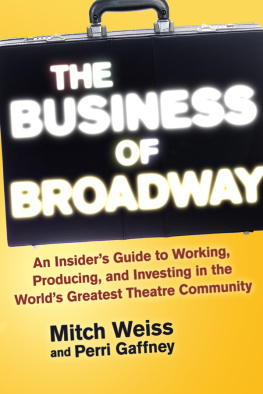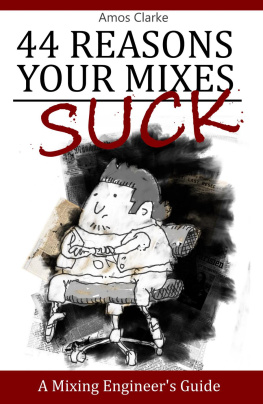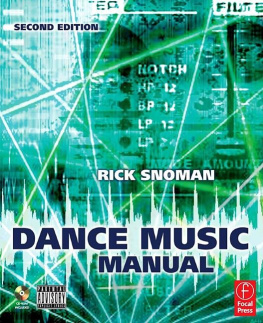Mixing a Musical
Broadway Theatrical Sound Techniques
Shannon Slaton
Focal Press
Front-matter
Mixing a Musical
Mixing a Musical
Broadway Theatrical Sound Techniques
Shannon Slaton
 AMSTERDAM BOSTON HEIDELBERG LONDON NEW YORK OXFORD PARIS SAN DIEGO SAN FRANCISCO SINGAPORE SYDNEY TOKYO
AMSTERDAM BOSTON HEIDELBERG LONDON NEW YORK OXFORD PARIS SAN DIEGO SAN FRANCISCO SINGAPORE SYDNEY TOKYO 
Focal Press is an imprint of Elsevier
Copyright
Focal Press is an imprint of Elsevier
225 Wyman Street, Waltham, MA 02451, USA
The Boulevard, Langford Lane, Kidlington, Oxford, OX5 1GB, UK
2011 Shannon Slaton. Published by Elsevier Inc. All rights reserved
No part of this publication may be reproduced or transmitted in any form or by any means, electronic or mechanical, including photocopying, recording, or any information storage and retrieval system, without permission in writing from the publisher. Details on how to seek permission, further information about the Publishers permissions policies and our arrangements with organizations such as the Copyright Clearance Center and the Copyright Licensing Agency, can be found at our website: www.elsevier.com/permissions.
This book and the individual contributions contained in it are protected under copyright by the Publisher (other than as may be noted herein).
Notices
Knowledge and best practice in this field are constantly changing. As new research and experience broaden our understanding, changes in research methods, professional practices, or medical treatment may become necessary.
Practitioners and researchers must always rely on their own experience and knowledge in evaluating and using any information, methods, compounds, or experiments described herein. In using such information or methods they should be mindful of their own safety and the safety of others, including parties for whom they have a professional responsibility.
To the fullest extent of the law, neither the Publisher nor the authors, contributors, or editors, assume any liability for any injury and/or damage to persons or property as a matter of products liability, negligence or otherwise, or from any use or operation of any methods, products, instructions, or ideas contained in the material herein.
Library of Congress Cataloging-in-Publication Data
Slaton, Shannon.
Mixing a musical : Broadway theatrical sound techniques / Shannon Slaton. 1st ed.
p. cm.
ISBN 978-0-240-81759-0 (pbk.)
1. TheatersElectronic sound control. 2. AuditoriumsElectronic sound control. 3. SoundRecording and reproducing. I. Title.
TK7881.4.S57 2011
792.024dc23
2011027538
British Library Cataloguing-in-Publication Data
A catalogue record for this book is available from the British Library
For information on all Focal Press publications visit our website at www.elsevierdirect.com
11 12 13 14 5 4 3 2 1
Printed in the United States of America

Dedication
To my wife, Mollie, thank you for all of your support.
To my son, Parker, you make me believe in superheroes.
To my daughter, Lizzie, yes you are a princess with magical powers.
Also to three of the best mixers I have ever known, Jordan Pankin, Bob Biasetti, and Francis Elers. I have learned most of what I know from these guys.
Finally to Patrick Pummill for being a great friend and one of my favorite people to talk shop with.
Foreword
Tony Meola
ON MY OWN, PRETENDING HES BESIDE ME.
ALL ALONE, I WALK WITH HIM TILL MORNING.
How many times did my fingers do everything they could to make sure the audience experienced the full power of those words from arguably the most beautiful song in a score filled with beautiful songs, Les Misrables? Not that my fingers were tripping along the keys of a piano, or clutching the bow of a violin, or strumming the strings of a guitar.
My fingers were on the sound console. Just about my favorite place in the world.
The only drawback to being a successful Broadway designer for 25 years is that I rarely get a chance to mix anymore. I oversee the mix. I note the mix. I even get to choose the mixer. But thats not the same thrill as being the person at the board, knowing that the slightest adjustment of any one of a number of knobs will subtlyyet greatlyimpact the audiences enjoyment of what theyre hearing.
A smart performer and a sensitive mixer is an unbeatable combination. How I loved giving that almost imperceptible bump in volume at the climax of a big dance number so the lead dancer could hear a little more, thus giving her the boost she needed to bring the number home. On those nights when that dancer (Im thinking of the late Deborah Henry as Cassie in the international tour of A Chorus Line) would shoot me a conspiratorial lookThanks, Tony!while never breaking character well, those are the moments Id hoped to one day have before I went into show business.
Back then, I didnt even know that a thing called sound design existed. I knew Id work behind the scenes, but I wasnt sure in what capacity. As soon as I stood at a console for the first time and realized that my love for and knowledge of music could be merged with my facility for equipment and electronics, I was hooked. Little did I appreciate that I was setting my sights on the most elusive of the four major design elements. After all, the scenery is on stage at its mark, or it isnt. Clear. The lights are on and at their appropriate color or theyre not. Clear. The actor is wearing a costume and its not inside out. Clear. But when the level for the leading ladys microphone is in its proper level for her 11 oclock spot not so clear. Except to the mixer, and (hopefully) the designer. Everyone else? Well, sound is nothing if not subjective. What sounds great to your ears might sound terrible to someone elses. Lesson number one: TRUST YOUR EARS.
Thats why those lyrics from Les Miz mean so much to me: on my own. Thats how the mixer sometimes feels, I know from experience. And I imagine thats how many a performer feels when s/he is in the spotlight. But the truth is, the two are linked: what the one is singing or saying, the other makes sure can be heard. I remember mixing Frances Ruffelle, the original Eponine in Les Miz on Broadway. Maybe its because Les Miz was the last show I officially mixed before making the transition to sound designer. Or maybe its because Frances and I collaborated so well. I remember discussing with her the poetic nature of the lyrics to On My Own, which employed sensual, visual imagery that Frances conveyed beautifully. The next night, I did my part, and when she got to the lyric:
IN THE RAIN, THE PAVEMENT SHINES LIKE SILVER.
ALL THE LIGHTS ARE MISTY IN THE RIVER
I touched-up the reverb on her ss and ts. The resulting shimmer in her voice worked in tandem with her interpretation of the song. The audience response was even wilder than usual. And Frances knew that she was not on her own. I was beside her, albeit at the back of the house, and very proud to be an integral part of presenting our show as artfully as possible.
Of course, not all performers are Frances Ruffelle. In fact, few are. Less secure singers often have inconsistent, sometimes erratic responses to what they perceive to be nightly changes in sound quality. I say perceived, because the actor is usually in the worst position to judge what were hearing in the front of the house, which is quite different from what hes hearingespecially when there are no vocal monitors on stage. So in addition to striving for consistency in the mix, its crucial that a mixer understand that part of his job is to liaise with the performers; regular visits backstage for some face time with your cast will result in their having more confidence on stage. Makes sense, doesnt it? If the cast knows you care, that you areat every momentwith them, that you love their performances and your job, they will assume you have their ears, if not their back. Psychology 101, to be surebut then a good mixer should study human nature as rigorously as he studies the latest model of microphone.
Next page









 AMSTERDAM BOSTON HEIDELBERG LONDON NEW YORK OXFORD PARIS SAN DIEGO SAN FRANCISCO SINGAPORE SYDNEY TOKYO
AMSTERDAM BOSTON HEIDELBERG LONDON NEW YORK OXFORD PARIS SAN DIEGO SAN FRANCISCO SINGAPORE SYDNEY TOKYO 
